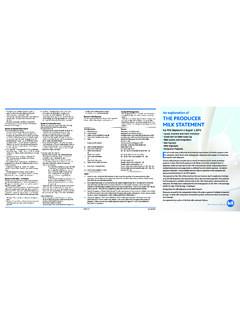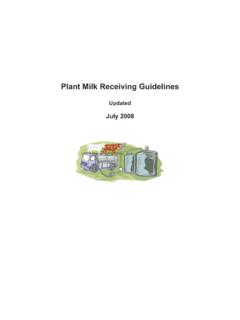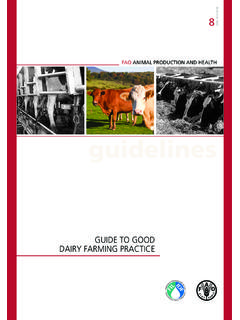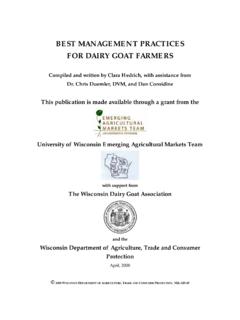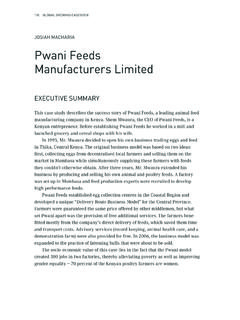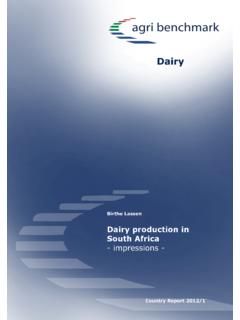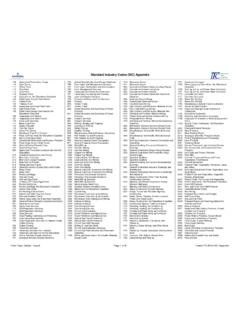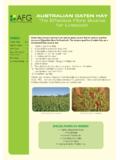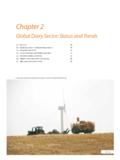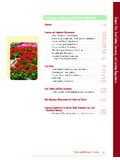Transcription of Facts & Figures About Canadian Dairy Cows - Milk
1 Facts & Figures About CanadianThere are a couple of basic variations in Dairy cattle housing thetie-stall or free stall setup. Size of herd and the farmer s preferencesfor management and milking all play a part in housing a traditional tie-stall operation, the cow stays in her own stall whereshe has ample room to stand up and lie down comfortably. Her bed ismade of straw, wood shavings or synthetic mats that ensure hercomfort. She has free access to water at all times and feed isavailable in her manger. She is kept beside her herd mates in aislesthat allow the farmer to keep her clean and content while allowingher to be milked efficiently. The milk travels through a pipeline thatruns through the barn to a bulk storage tank in the milk managers of larger herds may prefer large, open barns knownas free-stall barns.
2 Twice a day, or more, the cows will enter a milkingparlour, an area designed specifically for ease and efficiency ofmilking, and the rest of the time they spend lounging around indoorsin adjoining barns where they eat, rest and move around as theychoose. Bedded stalls are provided for the cows to lie down. Barnaisles are often cement or slatted floors that allow easy clean up ofmanure. cows have free choice feed and some farms use acomputerized transponder tag that identifies them when they production all revolves around the reproductive cycle of the are usually milked for About ten months and then dried off (stopmilking) for two months as they prepare for the birth of a calf. Drycows are commonly grouped together in yards or pastures for six toeight weeks before calving (giving birth).
3 Calves are kept in pens inthe barn or in their own individual building called a : Where do Dairy cows Live?You were asking CowsDairy cows In General: Average number of cows in milking herd: 70 Canada has 12,529 Dairy farms with almost 1 million cows Canadian Dairy farmers sell an average of billion litresof milk annually to processors Three main processors process approximately 80% of the milkproduced in Canada There are approximately 450 milk processors in Canada 700 kinds of cheese are made in Canada Sales of milk and Dairy products contribute $10 billion to the Canadian economy Ontario s milk production in 2012 was billion litres of milk The farm gate value of milk from Ontario s Dairy farms is About $ billion annually and accounts for About 19 per cent of the province s agricultural production Licensed Dairy farms in Ontario as of December 2012.
4 4,100 Average age of Canadian Dairy farmers: 47 Number of Dairy cows in Ontario in 2012: 315,000 milking cows plus 173,000 heifers over one year courtesy of Dairy Farmers of OntarioDairyThe average Dairy cow eats About 29 kg of feed every day. Her diet isscientifically formulated to keep her in good condition while maximizingher milk production. The feed may include clover and alfalfa hay, groundoats, barley, corn, and soybeans, combined with a balance of vitaminand mineral supplements. She may drink between 80 and 180 litres ofwater a are herbivores, meaning that their diet consists of plant sheep and goats they are also ruminants: instead of having justone stomach like humans, they have four separate stomachcompartments that allow specialized digestion of different componentsof the high-fibre whole digestive process takes a while.
5 A cow will spendapproximately six hours a day eating and approximately eight hours aday chewing its cud: regurgitating boluses of feed from the rumen (thefirst stomach compartment), masticating (chewing) them, and re-swallowing them to be further digested in the next three stomachchambers called the reticulum, omasum and abomasum. This lengthyprocess allows them to efficiently digest low-grade, fibre-based receive colostrum, milk that contains the mother s antibodies,for their first three days. After that, calves are fed either cow s milk ora milk replacer (similar to human baby formula) until they are oldenough for solid food, which is slowly introduced as part of the diet toprepare the calves for the Life Cycle of Dairy order for a cow (adult female) to produce milk, she has to give birthto a calf.
6 cows are usually bred at around 15 months of age, and aftera nine-month pregnancy they will have their first calf at About two yearsof Dairy cattle today are bred using artificial insemination. The bulls(male cattle) are kept at breeding units and the semen can be shippedfrozen in straws, sometimes from all around the will usually give birth to a single calf weighing About 40 kg. Thecalf will be fed individually while the cow will enter the milking will produce milk for About 10 months. She will stop milk productionduring a two-month dry period to prepare for the birth of her nextcalf. An average cow will produce About 30 litres of milk per day, muchmore than a calf could consume. The cows are milked two or threetimes each day. The milk will naturally contain About to 4% butterfatcontent and to protein.
7 Even with automated milking machines,a typical Dairy farmer will be in the barn by 5 to milk the herd andagain at 5 , 365 days a year. Most cows will have an average productive lifespan of four or fivelactations. Some cows milk for 10 lactations or more. Female calvesmay be raised as replacement heifers for the herd, while the male calvesare typically raised for to MarketSome of the milk may be used to feed young calves but the majority isstored in a refrigerated tank on the farm and picked up every other is transported by truck to a Dairy processing plant to be pasteurized(heat treated) and sold fresh or further processed into products suchas cheese, ice cream, or yogurt. It takes two to three days for fresh milkto get from the farm to the store. Since 1965, Dairy farmers have worked under a supply managementsystem that is now administered by the provincial Dairy farmerorganizations.
8 Supply management refers to producing the exact amountof milk required by Ontario milk processors to meet consumer system has allowed the Dairy industry to prosper, providing aconstant, reliable supply of high-quality milk products for consumersat reasonable prices while ensuring a fair return to the Dairy farming, medication is only used if it is required to treat aspecific illness. When Dairy animals become ill, the problem isdiagnosed and, with the help of a veterinarian, a treatment program isestablished. Her milk is discarded since it is illegal to sell or offer forsale any milk that contains antibiotics or other pharmaceuticals, andshe is milked separately from the rest of the herd until she has compliedwith strict withdrawal periods for her specific Canada, there is a stringent Dairy inspection program in place to testmilk.
9 Samples are taken at each farm for quality and composition. Aswell, each truckload is tested for antibiotics at the Dairy . Any milk thatdoes not pass the test is discarded immediately and any producer whosemilk is found to contain antibiotics faces heavy financial penalties. Nutrition: What Do Dairy cows Eat? Dairy DictionaryHere are a few terms you need to know to get arounda Dairy cow farm: Calf:A newborn bovine or Dairy animal. Heifer:A young female that has not yet had a calf andbegun to milk. Cow:A mature female bovine or Dairy animal. Bull:A mature male bovine or Dairy animal. Pipeline milking system: The cows are tied in theirstalls, the udders washed and a milking machine attachedto all four teats on the cow s udder. A hose runs from themilking machine to a stainless steel pipeline located overthe cow s head.
10 The pipeline runs the length of the barnand is connected to a big bulk tank in the milkhouse. Milking parlour:The cows walk onto a raised platformwith gates. The gates keep the cow from moving while sheis being milked. When milking is over, she walks out theother side. The milk goes directly through a pipeline to thebulk tank in the milkhouse. Robotic milking system: Similar to a parlour system,except that the entire milking system is automated. Cowscan enter the robot at anytime during the day to bemilked. A warning system alerts the farmer if there is aproblem with a cow or the milking system. Hay: A mixture of grass and legumes, like alfalfa. It is most commonly used in two ways: -Haylage: the hay is cut, chopped and stored in a looseway in a storage silo, while it is still moist. -Hay: usually cut after haylage when the plants aretaller, it is allowed to dry in the field.
